
Landing craft loaded with Marines head for the smoking beach in
invasion of Inchon,
September 15, 1950.
Sgt. Frank C. Kerr. (Marine
Corps)

A U.N. LST slips into the harbor at Inchon prior to invasion by
U.S. Marines.
December 13, 1950. (Navy)

F4U's (Corsairs) returning from a combat mission over North Korea
circle the USS Boxer as they wait for planes in the next strike to be launched
from her flight deck - a helicopter hovers above the ship.
September 4,
1951. (Navy)

View of F-86 airplanes on the flight line getting ready for
combat.
June 1951. Air Force. (USIA)

The Pantherjets are refueling after rockets have been "hung" under
the wings.
Ca. 1951.
M.Sgt. C.D. Prindle. (Marine Corps)

An aircraft maintenance crew of the U.S. Air Forces 4th
Fighter-Interceptor Wing in Korea, photographed through the tail-pipe of an F-86
Sabre, hoists an engine into place for installation on one of the jet fighter
planes.
September 1951. (USIA)
Exact Date Shot Unknown

An HRS-1 Sikorsky helicopter hovers close to the ground while
Marines hook a cargo net loaded with 1,000 pounds of supplies for transportation
to the front 12 miles away.
Ca. 1951. M.Sgt. Ed. Waite. (Marine
Corps)

Maj. Gen. Frank Lowe, USA, presidential representative in Korea,
examines "flash range" instruments on the Marine front lines. Explaining the
instrument is Marine S.Sgt. Charles Kitching of Redlands, Calif.
March 1951.
T. Sgt. Vance Jobe. (Marine Corps)
Exact Date Shot Unknown

Three BD-110A switchboards on left and one BD-96 on extreme right
being operated by Pfc. James Grahn of Co. B, 71st Sig. Svc. Bn., Pusan, Korea.
August 1, 1950. Cpl. Crowe. (Army)

Invasion of Ichon, Korea. Four LST's unload men and equipment on
beach. Three of the LST's shown are LST-611, LST-745, and LST-715.
September
15, 1950. C.K. Rose. (Navy)

"Freedom Gate Bridge" spanning the Imjin River, built by the 84th
Engineer Construction Bn. This bridge temporarily replaces the original
structure which was destroyed by bombs.
March 10, 1952. G. Dimitri Boria.
(Army)

Supplies and equipment are also evacuated from the onslaught of
the Communist Forces bearing down on Hungnam, Korea.
December 11, 1950. Pfc.
Emerich M. Christ. (Army)

Railroad cars loaded with barbed wire at Taegu RTO (Railway
Transportation Office), Korea.
July 24, 1950.
Sgt. Riley.
(Army)

Marine Corps tanks - ready for the front lines - are swung aboard
a barge at the Naval Supply Center by crane, for transhipment to our forces in
the Pacific Far Eastern Command. Oakland,
CA, 1950. Acme. (USIA)

A view of the U.N. fuel dump at Inchon Harbor, Korea. Hundreds of
fuel drums are lifted and moved with cranes from a tanker onto the ground.
March 7, 1952.
G. Dimitri Boria. (Army)

Lt. Col. John Hopkins, commanding officer of the First Battalion,
Fifth Marine Regiment, leads in singing the "Star Spangled Banner" during
Memorial Services held in the field during the Korean campaign.
June 21,
1951.
Cpl. Valle. (Marine Corps)

U.S. Marines stand along the rail and watch the ocean aboard the
USS Clymer. To the aft a Marine is washing his dungarees by dragging them along
behind the ship.
July 1950.
Sgt. Frank C. Kerr. (Marine
Corps)

Missouri infantrymen with the 19th Inf. Regt. along the Kumsong
front wish Happy New Year to the stateside folks.
December 14, 1951.
Cpl. Mervyn Lew. (Army)

With nearly 3,000 pin-ups (including over 200 shots of Marilyn
Monroe) serving as wallpaper for their Quonset hut, these Marines of the
"Devil-cats" squadron are still looking for more,
October 28, 1952.
Sgt.
Curt Giese. (Marine Corps)

Pfc. Clarence Whitmore, voice radio operator, 24th Infantry
Regiment, reads the latest news while enjoying chow during lull in battle, near
Sangju, Korea. August 9, 1950.
Pfc. Charles Fabiszak, Army.
(USIA)

Catching up on his letters to the folks at home during a break
Communist forces along the fighting front in Korea, is Pfc. Dwight Exe, 5th Cav.
Regt. November 15, 1951.
Cpl. James L. Chancellor. (Army)

Former American and Australian prisoners of war warming up before
a stove in the 24th Division medical clearing station after being returned to
U.S. lines by Chinese Communists,
February 10, 1951.
Sfc. Al Chang.
(Army)

Pfc. Edward Wilson, 24th Inf. Regt., wounded in leg while engaged
in action against the enemy forces near the front lines in Korea, waits to be
evacuated to aid station behind the lines.
February 16, 1951.
Pfc.
Charles Fabiszak. (Army)

Pfc. Preston McKnight, 19th Inf. Regt., uses his poncho to get
protection from the biting wind and cold, in the Yoju area, during break in
action against the Chinese Communist aggressors.
Janurary 10, 1951.
Cpl.
E. Watson. (Army)

Astonished Marines of the 5th and 7th Regiments, who hurled back a
surprise onslaught by three Chinese communist divisions, hear that they are to
withdraw! Ca.
December 1950. Sgt. Frank C. Kerr. (Marine Corps)

Marines of the 1st Marine Division relax by a Korean hut after
destroying an enemy sniper housed there.
September 24, 1951.
T. Sgt.
Frank W. Sewell. (Marine Corps)

Men at Munsan-ni, preparing for inspection prior to acting as
honor guard at signing of armistice at Panmunjom, Korea. Navy men shining their
shoes.
July 23, 1953. (Navy)

Fresh and eager U.S. Marine troops, newly-arrived at the vital
southern supply port of Pusan, are shown prior to moving up to the front lines.
August 1950. INP. (USIA)
Exact Date Shot Unknown

Ethiopian troops training in Korea. A class in military
intelligence instructed by Lt. Solomon Mokria of Addis Ababa.
May 1951.
Gahn, State Dept. (USIA)
Exact Date Shot Unknown

An ROK soldier guards the Panmunjom road near the UN delegates
base camp, Munsan-ni.
March 15, 1952.
G. Dimitri Boria.
(Army)

During South Korean evacuation of Suwon Airfield, a 37-mm
anti-tank gun is hauled out of the area for repairs, by a weapons carrier.
1950. INP. (USIA)
Exact Date Shot Unknown

Officers and men of the 62nd Engineers stand in front of the first
train to cross the new railroad bridge which they built across the Han River at
Seoul, Korea.
October 19, 1950.
Sfc. Albert Guyette. (Army)

Men of the 24th Inf. Regt. move up to the firing line in Korea.
July 18, 1950.
Breeding. (Army)

Troops of the 31st Inf. Regt. land at Inchon Harbor, Korea, aboard
LST's.
September 18, 1950.
Hunkins. (Army)

U.S. troops are pictured on pier after debarking from ship,
somewhere in Korea.
August 6, 1950.
Sgt. Dunlap. (Army)

San Diego, Calif. A young officer and his wife sitting in their
car at the dock and staring quietly at the waiting aircraft carrier before he
leaves for Korea. 1950. Black Star. (USIA)
Exact Date Shot
Unknown

Cpl. John W. Simms of Bradbury Heights, MD, is shown bidding his
wife, Ann, and their 8-month-old son, John Jr., goodbye as he leaves for Korea,
1950. Washington Post. (USIA)
Exact Date Shot Unknown

The Hon. S.Y. Lee, Vice President of South Korea, leads cheers at
the close of the UN Day ceremony at Seoul.
October 24, 1950.
Sgt. Ray
Turnbull. (Army)

At U.N. Security Council, Warren Austin, U.S. delegate, holds
Russian-made submachine gun dated 1950, captured by American troops in July
1950. He charges that Russia is delivering arms to North Koreans. Lake Success,
NY,
September 18, 1951. INP. (USIA)

Gen. Douglas MacArthur addressing an audience of 50,000 at
Soldier's Field, Chicago, on his first visit to the United States in 14 years,
April 1951. Acme. (USIA)
Exact Date Shot Unknown

Lt. Gen. Matthew Ridgeway; Maj. Gen. Doyle Hickey; and Gen.
Douglas MacArthur, Commander in Chief of U.N. Forces in Korea, in a jeep at a
command post, Yang Yang, approximately 15 milies north of the 38th parallel,
April 3, 1951. Grigg. (Army)

General of the Army Douglas MacArthur is shown inspecting troops
of the 24th Inf. on his arrival at Kimpo airfield for a tour of the battlefront.
February 21, 1951. INP. (USIA)

Brig. Gen. Courtney Whitney; Gen. Douglas MacArthur, Commander in
Chief of U.N. Forces; and Maj. Gen. Edward M. Almond observe the shelling of
Inchon from the U.S.S. Mt. McKinley,
September 15, 1950. Nutter
(Army)

Jacob A. Malik, Soviet representative on the U.N. Security
Council, raises his hand to cast the only dissenting vote to the resolution
calling on the Chinese Communists to withdraw troops from Korea. Lake Success,
NY.
December 1950. INP. (USIA)
Exact Date Shot Unknown

President Harry S. Truman is shown at his desk at the White House
signing a proclamation declaring a national emergency.
December 16, 1950.
Acme. (USIA)

With her brother on her back a war weary Korean girl tiredly
trudges by a stalled M-26 tank,
at Haengju, Korea.
June 9, 1951. Maj.
R.V. Spencer, UAF. (Navy)

A little Korean girl places a wreath of flowers on the grave of an
American soldier,
while Pfc. Chester Painter and Cpl. Harry May present
arms,
at the United Nations cemetery in Pusan.
April 9, 1951. Cpl. Alex
Klein. (Army)

Repatriated POW Capt. Frederick Smith is greeted by his father on
his arrival at Fort Mason,
Calif., on board the USNS Marine Phoenix.
September 14,
1953. Herb Weiss. (Army)

1st Lt. Alvin Anderson, one of the many repatriated POW's to
return home aboard the
USNS Marine Phoenix, embracing his mother and sister
as other members of his family look on.
Fort Mason, CA, September 14,
1953. Herb Weiss. (Army)

U.N. correspondents at the armistice building, Panmunjom, Korea.
July 23, 1953. Weber. (Navy)

Gen. W. K. Harrison, Jr., signs armistice ending 3-year Korean
conflict. Gen. Harrison,
left table, and North Korean Gen. Nam II, right
table, sign documents.
July 23, 1953. F. Kazukaitis. (Navy)

Col. James Murray, Jr., USMC, and Col. Chang Chun San, of the
North Korean Communist Army,
initial maps showing the north and south
boundaries of the demarcation zone,
during the Panmunjom cease fire talks.
October 11, 1951. F. Kazukaitis. (Navy)

The families of the returning POW's waving and greeting the ship
the General Nelson M.
Walker as it docks at Fort Mason, California.
August 23, 1953. Pfc. Brink. (Army)

Panmunjom, Korea, the site of military armistice negotiations
between representatives
of the Communist forces fighting in Korea, and
United Nations forces representatives.
November 1, 1951.
Capt. Edward W.
Plummer. (Army)

Marines of the First Marine Division pay their respects to fallen
buddies during memorial services at the division's cemetery at Hamhung, Korea,
following the break-out from Chosin Reservoir,
December 13, 1950.
Cpl.
Uthe. (Marine Corps)

Cpl. Charles Price sounds "Taps" over the graves of fallen
Leathernecks during memorial services at the First Marine Division cemetery at
Hungnam, following the division's heroic break-out from Chosin Reservoir.
December 13, 1950. Cpl. W. T. Wolfe. (Marine Corps)

A wounded chaplain reads a memorial service over the snow-covered
bodies of dead Marines. Koto-ri, Korea.
December 3, 1950.
Cpl. W. T.
Wolfe. (Marine Corps)
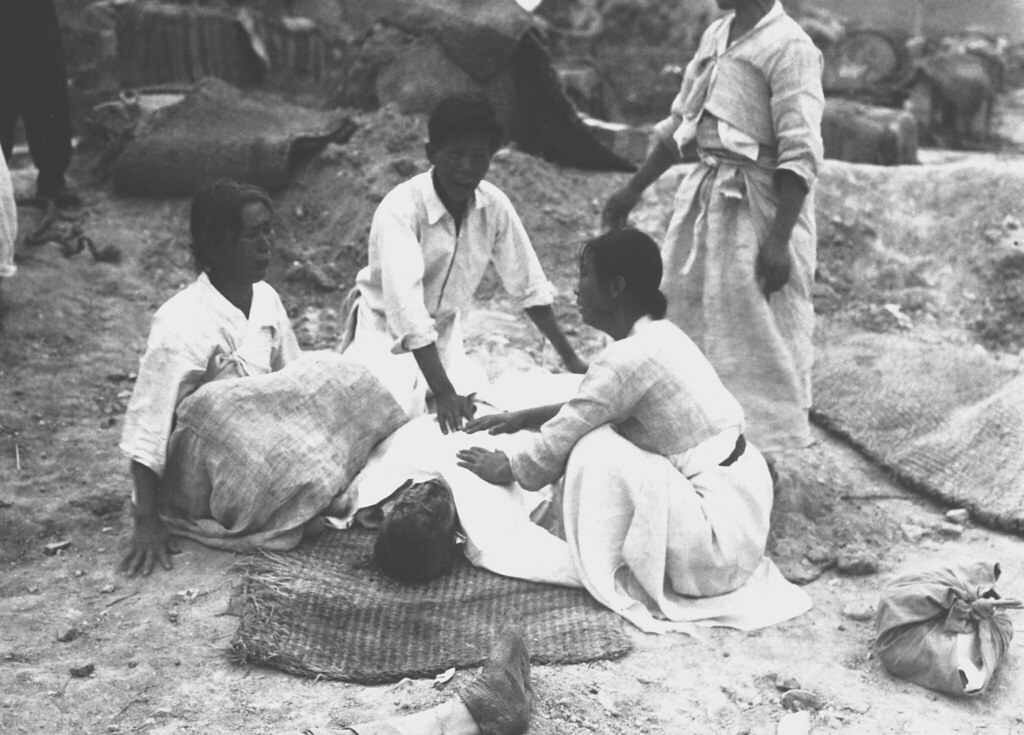
A Korean family mourns their murdered father, victim of the
wholesale murder at Chonju by North Koreans.
September 27, 1950.
M. Sgt.
E. T. Tarr. (Army)

How a man died on the way to Maeson Dong. S
eptember 2, 1950.
Sgt. Turnbull. (Army)

General view of buildings in the suburbs of Seoul, Korea,
destroyed by artillery and air strikes.
August 20, 1951.
G. Dimitri
Boria. (Army)

An aged Korean woman pauses in her search for salvageable
materials among the ruins of Seoul, Korea.
November 1, 1950.
Capt. C. W.
Huff. (Army)

Korean women and children search the rubble of Seoul for anything
that can be used or burned as fuel.
November 1, 1950.
Capt. F. L.
Scheiber. (Army)

ROK military police pose before the ruins of a devastated building
in Pohang. Most buildings that housed red troops were destroyed.
October 17,
1950. (Navy)

Scene of war damage in residential section of Seoul, Korea. The
capitol building can be seen in the background (right).
October 18, 1950.
Sfc. Cecil Riley. (Army)

Wreckage of big transport which North Koreans hit while it was on
Kimpo Airfield, is again in friendly hands, upon recapture of field.
September 18, 1950.
Sgt. Frank C. Kerr. (Marine Corps)

The wreckage of a bridge and North Korean Communist tank south of
Suwon, Korea. The tank was caught on a bridge and put out of action by the Air
Force. October 7, 1950.
Marks. (Army)

Return of POW's during Operation "Big Switch," Panmunjom, Korea.
Communist POW's ripped off their clothing and strewed it along the road. Some of
the clothing is burning. August 12, 1953. Larsen. (Navy)

This anti-Communist North Korean just released from a prisoner of
war camp is serving as a kind of cheerleader for fellow ex-POW's as they shout
their joy of reaching Seoul. The flags are of the Republic of South Korea.
Ca. 1953-54. Gravy. (USIA)
Exact Date Shot
Unknown

U.S. Marines wounded at Kari San Mountain are evacuated via
helicopter and
flown to hospital in near areas for treatment. Navy Corpsmen
prepare three
wounded Marines for evacuation.
May 23, 1951.
N.H.
McMasters. (Navy)

Crew members of Co. D, 89th Tank Bn., give first aid to wounded
soldier,
during action against the Chinese Communist forces north east of
Seoul, Korea.
May 1, 1951.
Pfc. Charles Fabiszak. (Army)

In bitter fighting on Hook Ridge, Marines threw back 800
screaming, bugle-blowing Chinese. A wounded Marine is given a drink of water by
buddies as he lies awaiting evacuation to a rear area aid station.
November
1952.
T.Sgt. Robert Kiser. (Marine Corps)

A wounded U.S. Marine awaiting transportation back to a field
hospital after receiving first-aid at the battle zone.
Defense Dept.
(USIA)
Exact Date Shot Unknown

A wounded American is lifted onto a helicopter at the 21st Inf.
Regt. collecting station at Painmal,
Korea, one mile sout of the 38th
Parallel, for evacuation to a base hospital.
April 3, 1951

Wounded American soldiers are given medical treatment at a first
aid station, somewhere in Korea.
July 25, 1950. Pfc.
Tom Nebbia.
(Army)
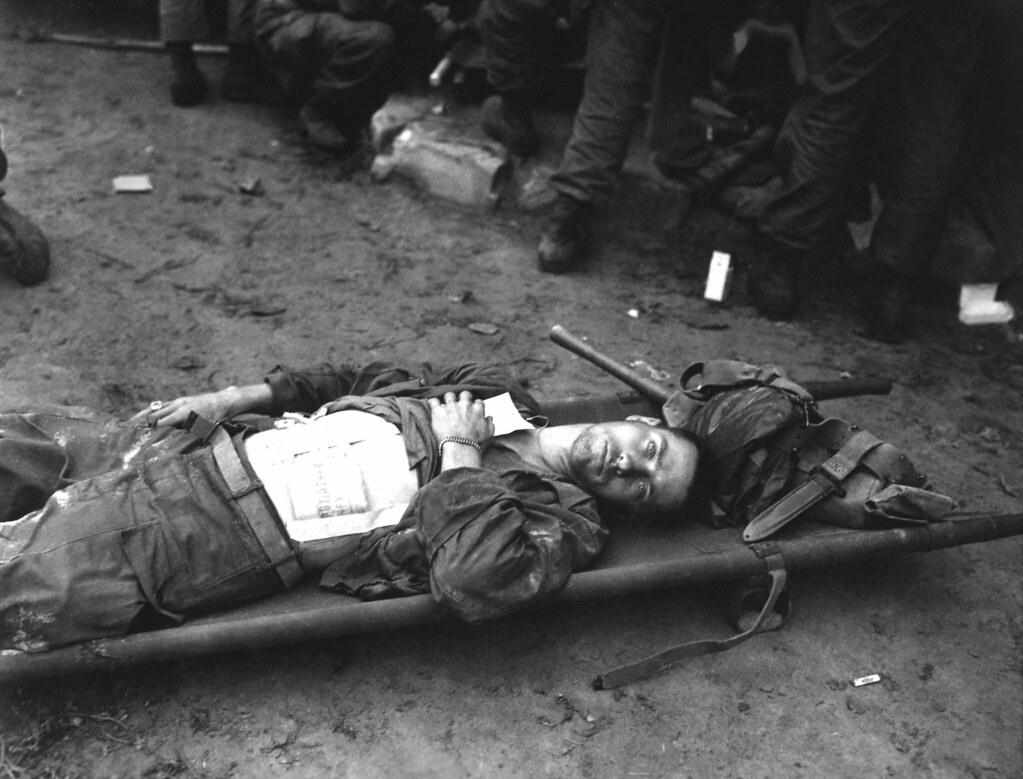
Pfc. Thomas Conlon, 21st Inf. Regt., lies on a stretcher at a
medical aid station,
after being wonunded while crossing the Naktong River
in Korea.
September 19, 1950.
Cpl. Dennis P. Buckley. (Army)

Buddies aid wounded man of 24th Inf. Regt., after a battle 10
miles south of Chorwon, Korea.
April 22, 1951.
Cpl. Tom Nebbia.
(Army)

The USS Missouri fires 16-inch shell into enemy lines at Hungnam.
A 16-inch 3-gun salvo is on its way to commies.
December 26, 1950.
(Navy)

A 16-inche salvo from the USS Missouri at Chong Jin, Korea, in
effort to cut Northern Korean communications.
Chong Jin is only 39 miles
from the border of China.
October 21, 1950. (Navy)

Supply warehouses and dock facilities at this important east coast
port feel the destructive weight of para-demolition bombs dropped from Fifth Air
Force's B-26 Invader light bombers, Wonsan, North Korea.
Ca. 1951. Air
Force. (USIA)
Exact Date Shot Unknown
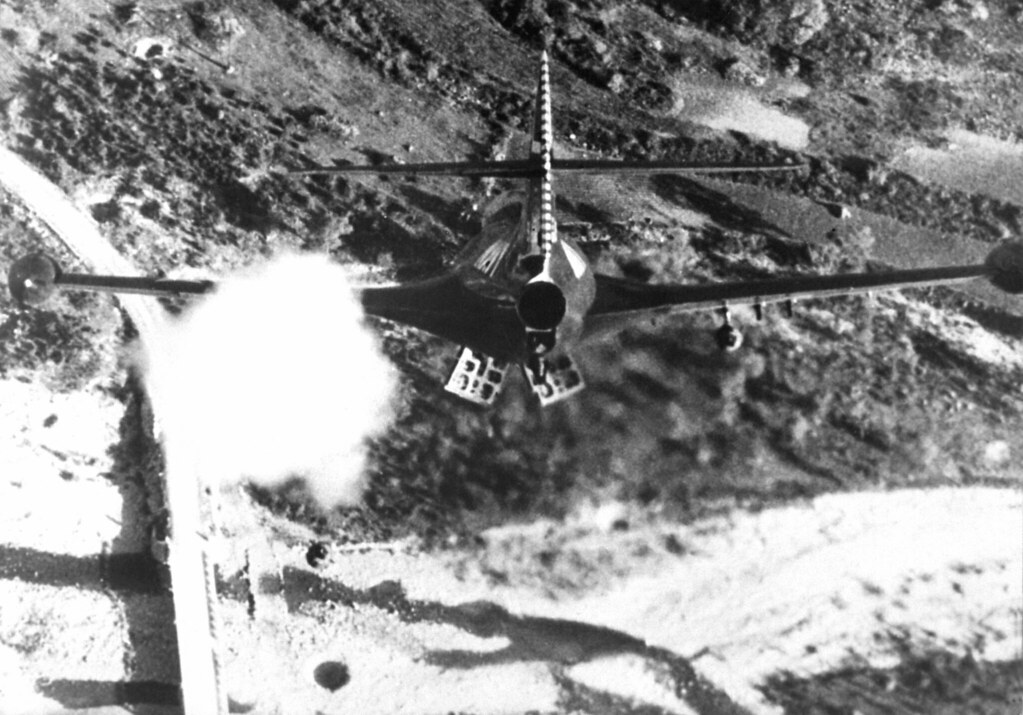
Lt. R. P. Yeatman, from the USS Bon Homme Richard, is shown
rocketing and bombing Korean bridge.
November 1952. (Navy)

Navy AD-3 dive bomber pulls out of dive after dropping a 2000 lb.
bomb on Korean side of a
bridge crossing the Yalu River at Sinuiju, into
Manchuria.
Note: anti-aircraft gun emplacement on both sides of the river.
November 15, 1950. (Navy)

Navy Sky Raiders from the USS Valley Forge fire 5-inch wing
rockets at North Korean communist field positions.
October 24, 1950.
PhoM3c. Burke. (Navy)
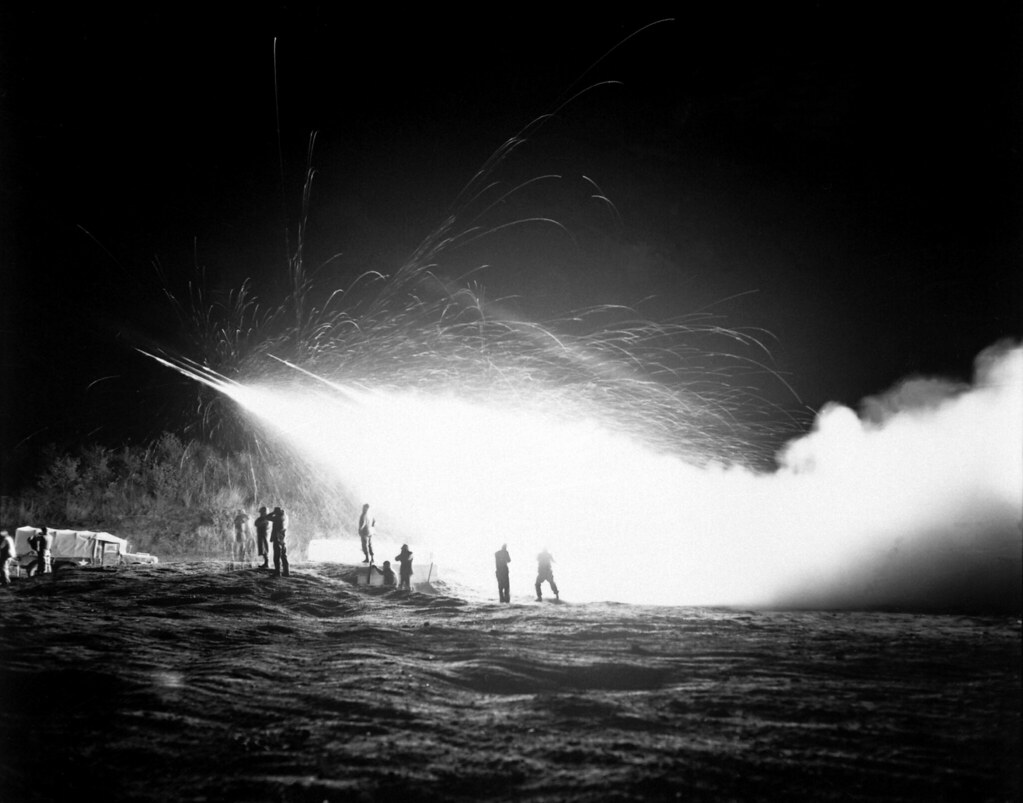
Night view of the First Rocket Battery, 11th Marine Regiment,
firing a night mission,
somewhere in the Marines front line sector.
April 15, 1953. M. Sgt.
Eugene C. Knauft. (Marine Corps)
h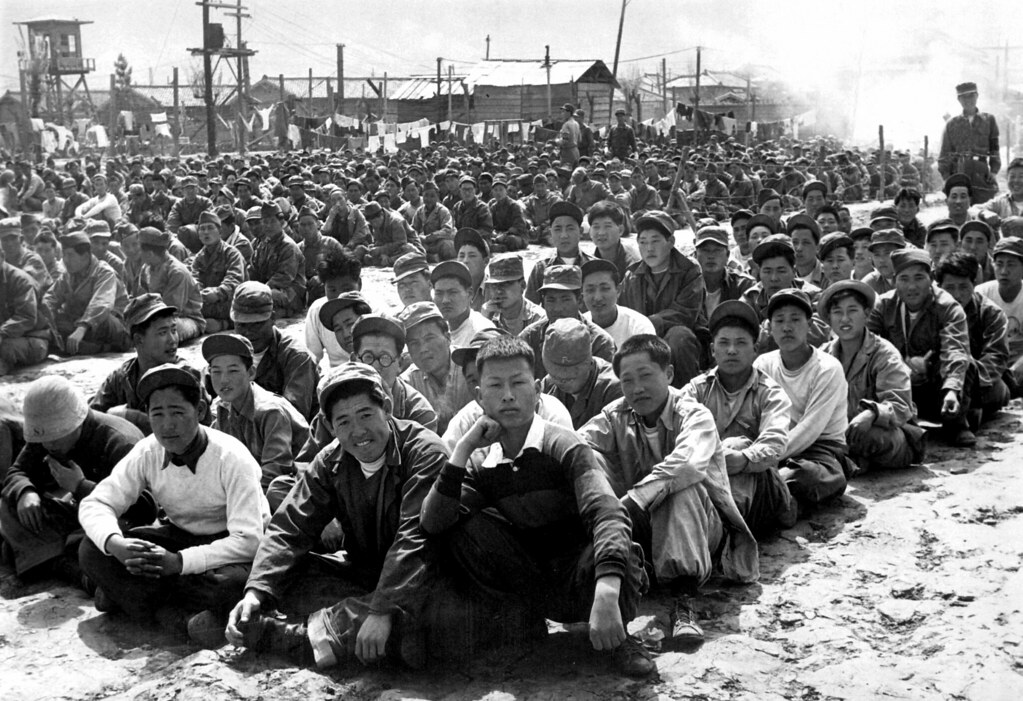
At the United Nations' prisoner-of-war camp at Pusan, prisoners
are assembled in one of the camp compounds. The camp contains both North Korean
and Chinese Communist prisoners.
April 1951. Gahn, State Dept.
(USIA)
Exact Date Shot Unknown

Communist guerrillas and their families, captured and brought down
from Mt. Chirisan, by elements of the ROK Captiol Division, are fed in the POW
stockade, Kurije, Korea.
December 12, 1951.
Cpl. Paul E. Stout.
(Army)

Two North Korean boys, serving in the North Korean Army, taken
prisoner in the Sindang-dong area by elements of the 389th Inf. Regt., are
interrogated by a U.S. soldier shortly after their capture.
September 18,
1950.
Pfc. Francis Mullin. (Army)

Men of the 1st Marine Division capture Chinese Communists during
fighting on the central Korean front. Hoengsong,
March 2, 1951.
Pfc. C.
T. Wehner. (Marine Corps)

Three Korean Communists in a fishing boat are captured by the USS
MANCHESTER off the coast of Korea.
May 10, 1951. (Navy)

A U.S. Marine tank follows a line of prisoners of war down a
village street.
September 26, 1950.
S. Sgt. John Babyak, Jr. (Marine
Corps)

North Korean prisoner of Marines who rolled enemy back in Naktong
River fighting. He wear a "Prisoner of War" tag and was treated in accordance
with United Nations' rules of international warfare.
September 4, 1950.
S. Sgt. Walter W. Frank. (Marine Corps)

U.S. Marines guarding three captured North Koreans, ca.
1950.
Sgt. W. M. Compton. (Marine Corps)
Exact Date Shot Unknown

North Korean prisoners, taken by the Marines in a foothills fight,
march single file across a rice paddy.
1950 (Marine Corps)
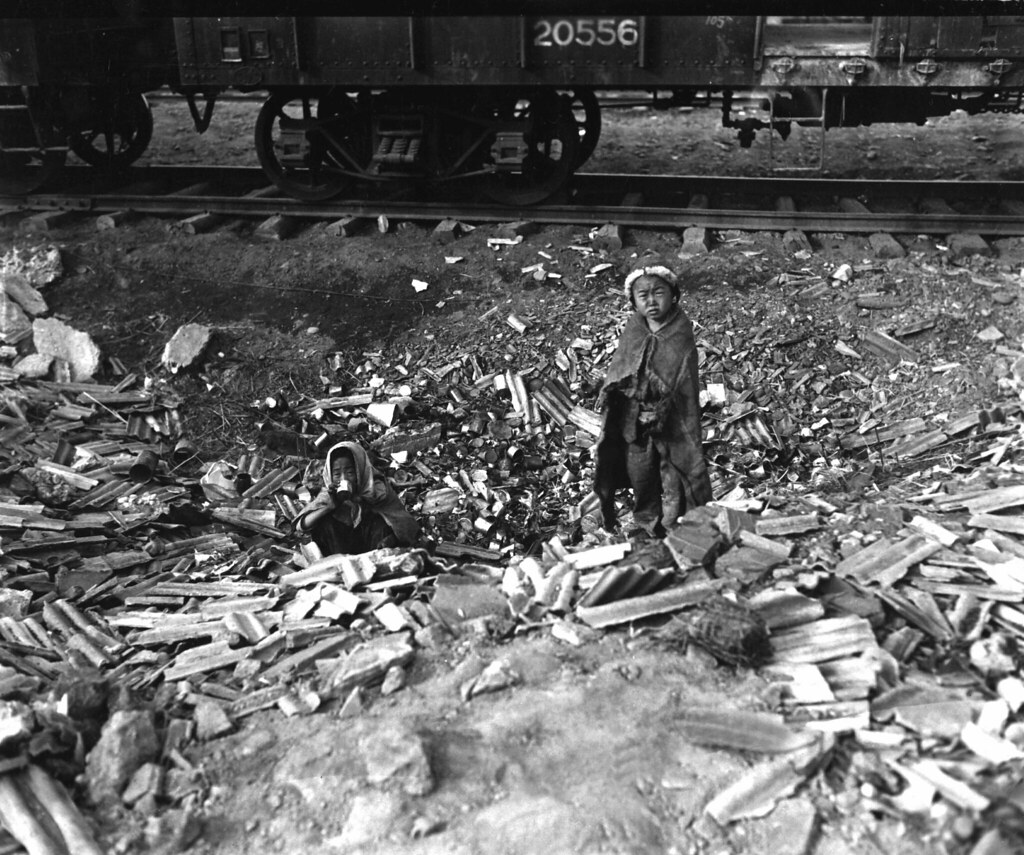
Homeless, this brother and sister search empty cans for morsels of
food, and try to keep warm beside a small fire in the Seoul, Korea, railroad
yards. November 17, 1950. Pfc. Fulton. (Army)

A small South Korean child sits alone in the street, after
elements of the 1st Marine Div. and South Korean Marines invaded the city of
Inchon, in an offensive launched against the North Korean forces in that area.
September 16, 1950.
Pfc. Ronald L. Hancock. (Army)

A Korean orphan boy adopted by a motor pool battalion at Inchon,
Korea and nursed back to health. He is called "Number one" by the boys of the
motor pool.
June 6, 1951. (Navy)

An old Korean man takes a rest on the street in front of destroyed
buildings, in Seoul.
August 20, 1951.
G. Dimitri Boria.
(Army)
|
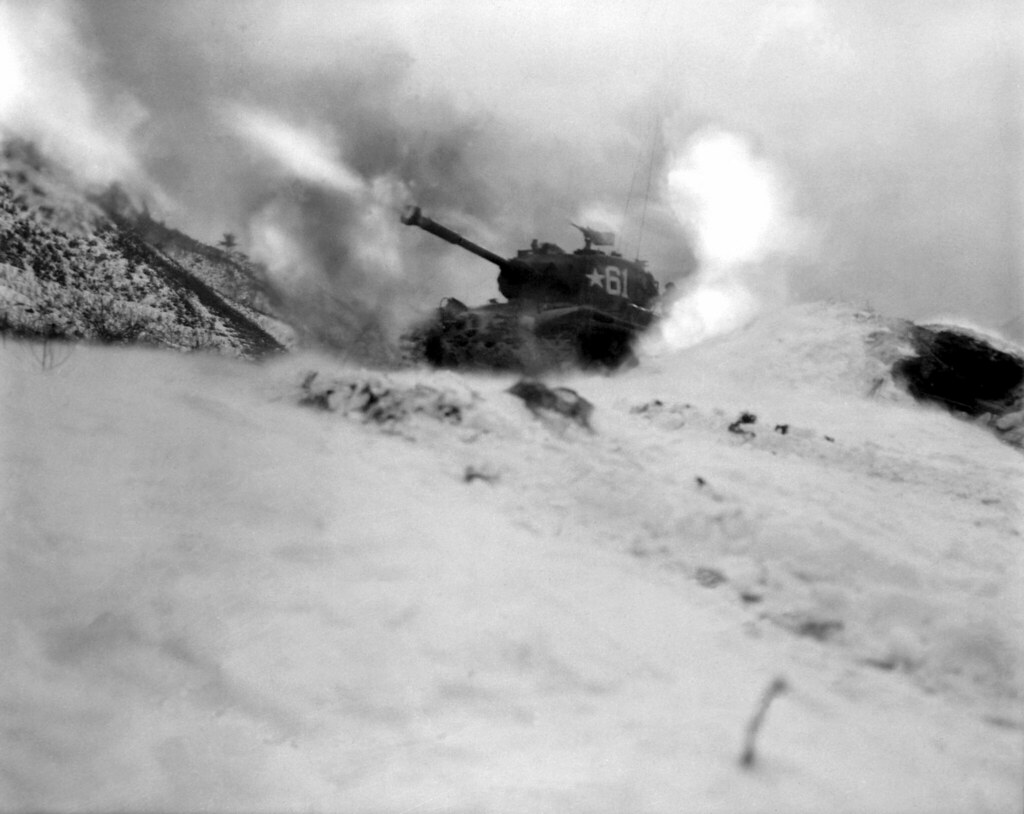
Near Song Sil-li, Korea, a tank of 6th Tank Bn. fires on enemy
positions in support of the 19th RCT.
January 10, 1952.
Pfc. Harry M.
Schultz. (Army)

Pfc. Roman Prauty, a gunner with 31st RCT (crouching foreground),
with the assistance of his gun crew, fires a 75mm recoilless rifle, near
Oetlook-tong, Korea, in support of infantry units directly across the valley.
June 9, 1951.
Peterson. (Army)

The Rockets Red Glare - U.S. Marines launch a 4.5 rocket barrage
against the Chinese Communists in the Korean fighting.
Ca. 1951. (Marine
Corps)

Men of the 4.2 mortar crew, 31st Heavy Mortar Co. fire at enemy
position, west of Chorwon, Korea.
February 7, 1953.
Sgt. Guy A. Kassal.
(Army)

Commandoes of the 41st Royal British Marines plant demolition
charges along railroad tracks of enemy supply line which they demolished during
a commando raid, 8 miles south of Songjin, Korea.
April 10, 1951.
(Navy)

Crossing the 38th parallel. United Nations forces withdraw from
Pyongyang, the North Korean capital. They recrossed the 38th parallel.
1950.
(USIA)
Exact Date Shot Unknown

U.S. Marines move forward after effective close-air support
flushes out the enemy from their hillside entrenchments. Billows of smoke rise
skyward from the target area. Hagaru-ri.
December 26, 1950.
Cpl.
McDonald. (Marine Corps)

Men of the 19th Inf. Regt. work their way over the snowy mountains
about 10 miles north of Seoul, Korea, attempting to locate the enemy lines and
positions.
January 3, 1951.
Pfc. James J. Jacquet. (Army)

U. S. Marines of the First Marine Div. Reconnaissance Co. make the
first helicopter invasion on Hill 812, to relieve the ROK Eighth Div., during
the renewed fighting in Korea.
September 20, 1951.
T. G. Donegan.
(Navy)

Men and equipment being parachuted to earth in an operation
conducted by United Nations airborne units.
Ca. 1951. Defense Dept.
(USIA)
Exact Date Shot Unknown

Paratroopers of the 187th RCT (Regimental Combat Team) float
earthward from C-119's to cut off retreating enemy units south of Munsan, Korea.
March 23, 1951.
Cpl. P. T. Turner. (Army)

Infantrymen of the 27th Infantry Regiment, near Heartbreak Ridge,
take advantage of cover and concealment in tunnel positions, 40 yards from the
Communists.
August 10, 1952.
Feldman. (Army)

Leatherneck machine gun crew dug in for the night in Korea.
Ca. 1950. (Marine Corps)
Exact Date Shot Unkown

Fighting with the 2nd Inf. Div. north of the Chongchon River, Sfc.
Major Cleveland, weapons squad leader, points out communist-led North Korean
position to his machine gun crew.
November 20, 1950.
Pfc. James Cox.
(Army)

Marine Pvt. 1st Class Luther Leguire raises U.S. Flag at American
consulate in Seoul, while fighting for the city raged around the compound.
September 27, 1950.
Sgt. John Babyak, Jr. (Marine Corps)

Leathernecks lead patrol between destroyed buildings in "mop-up"
of Wolmi Island, gateway to Inchon. S
eptember 15, 1950.
Sgt. Frank C.
Kerr. (Marine Corps)

United Nations troops fighting in the streets of Seoul, Korea.
September 20, 1950.
Lt. Robert L. Strickland and Cpl. John Romanowski.
(Army)

Men of the 9th Inf. Regt. man an M-26 tank to await an enemy
attempt to cross the Naktong River.
September 3, 1950.
Cpl. Thomas
Marotta. (Army)

Marine infantrymen take cover behind a tank while it fires on
Communist troops ahead. Hongchon Area,
May 22, 1951.
Sgt. John Babyak,
Jr. (Marine Corps)

As against "The Shores of Tripoli" in the Marine Hymn,
Leathernecks use scaling ladders to storm ashore at Inchon in amphibious
invasion
September 15, 1950.
The attack was so swift that casualties
were surprisingly low. S.Sgt. W.W. Frank. (Marine Corps)

Carrying scaling ladders, U.S. Marines in landing crafts head for
the seawall at Inchon.
September 15, 1950.
S.Sgt. W. W. Frank. (Marine
Corps)

Troops are climbing down cargo net to waiting LCVP's as they land.
January 9, 1953. (Army)
|
|
|
| | |
|
|
|
|
|
| | |
|
|
|





















































































































